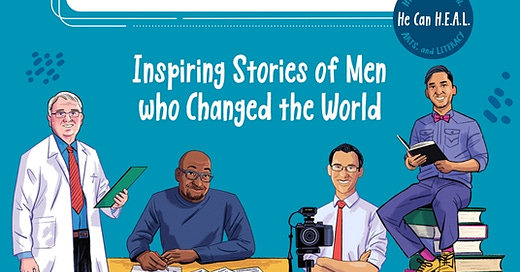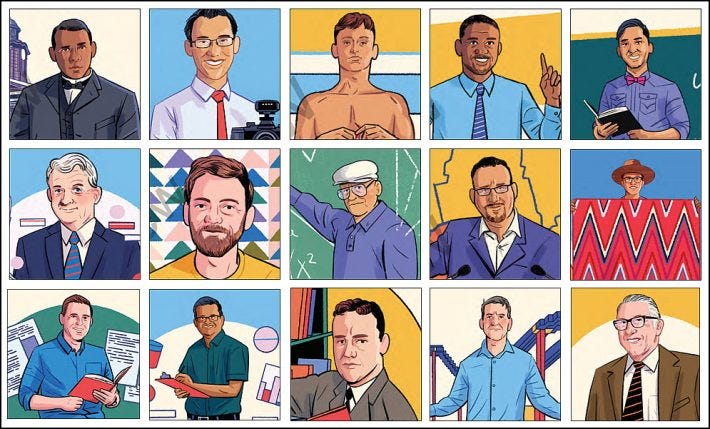New book alert: Yes Boys Can!
Encouraging more boys to consider jobs in HEAL, with a show not tell approach
STOP: If you don’t do anything else, please click here and preorder the book: thank you!
One of the employment trends I’m most worried about is the declining share of men in certain professions, especially health and education. I’ve written about this quite a bit, including in Of Boys and Men, Time magazine, and on these pages. Also over at the American Institute for Boys and Men we’ve done some work showing the declining share of men in education, and in mental health. As just one example, I often think of this chart:
I think this is bad news:
bad for men, who are missing out of some good job opportunities
bad for the professions, who are missing out on lots of male talent
bad for those served by those professions, who are missing the opportunity to be helped by someone like themselves
I have lots of policy ideas on this front; and I want to help more programs and initiatives tackle this crisis of representation.
But this is very much a cultural challenge. To have men in these professions, we need boys to see them as jobs they might consider. Right now, they generally don’t. And of course, as these professions have fewer and fewer men in them, it’s gets harder for boys and men to see them as jobs for people like then. As the great Gloria Steinem taught us:
You can’t be it if you can’t see it.
Enter: a brilliant book idea
So you can imagine my delight when the opportunity came to help with a book directly aimed at adolescent boys, and with the goal of disrupting the gender stereotypes attached to some many of these jobs.
This is largely done not by telling, but by showing: the book is based on 50 biographies of men, past and present, who have been pioneers in what are seen, wrongly, as “women’s jobs”. Selecting these men was perhaps the most fun part of th exercise.
Quarto Press was already planning a book aimed at girls, called “She can STEM”. Editor Jonathan Simcosky came up with the idea of a similar one for boys. He recruited me to the cause, as well as Jonathan Juravich, a dude of all-round total awesomeness, TED talker, and national elementary art teacher of the year in 2023. He also landed Chris King to produce some superb illustrations:
The whole story of the book’s creation is told here by Porter Anderson in Publishing Perspectives. The key point, as Jonathan Simcosky said, is that:
We have to learn from our past and imagine a new future. And maybe paying some attention to boys is the next frontier for gender equity.
Men in H.E.A.L.
One note on definitions: In my previous work, I’ve used the term “HEAL” to denote jobs in health, education, administration and literacy. It’s obviously a kind of mirror image to STEM. But in this book, the “A” stands for the arts, rather than for administration. The arts sector may not be that big, from an economic perspective, but it is hugely important culturally. Arts professions skew somewhat female in the labor market; but in the long run this skew might become greater, given the huge gender split in extracurricular engagement in the arts at schools. Plus, my co-author is an artist!
Among the men described in the book are:
Cliff Morrison, AIDS nurse.
At the age of 12, Cliff took a job as a custodian at a local hospital. He mopped floors and took out the trash. After a year of spending time in the hospital and around patients, he made a request to take care of patients. Cliff became a hospital orderly, supporting patients with day-to-day tasks or getting them from one place to another. He held this job through his high school graduation.
When the AIDs epidemic hit, Cliff was a nurse in San Francisco. Unlike other heathcare professionals, he reached out to touch and comfort those with the disease and refused to wear the spacesuit-like protective gear that those around him were wearing. He felt that they knew enough about the disease to know that providing compassionate medical care was not going to infect him with the disease. Healthcare facilities around the country later adopted Cliff’s methods.
Candido Cresto, visual artist
During high school, Candido faced some challenges requiring teachers to come alongside and help him. These caring teachers confirmed that he wanted to be a teacher and to pay it forward by supporting his future students through their challenges. Right after college, Candido was hired into his dream job, teaching high school art classes. Since then, he has taught intermediate, middle school, and elementary students. His goal wasn’t to develop a ton of working artists but to give students the confidence to try new things, explore possibilities, and face challenges with the knowledge that he was on their side.
While teaching in the classroom, Candido shares his art with his students. He wants them to see his creative process and the skills he has developed, that the creation of a work of art is not something just in the history books. Candido hosted a podcast called the Everyday Art Room; the audience was other art teachers who were learning alongside him as he engaged with guest artists and educators each week.
Sir Jonathan Elliott Asbridge, Nurse-Knight
Among the others is the Cardiff-born nurse Sir Jonathan Elliott Asbridge (My Mom is Welsh, a retired nurse, and lives in Cardiff, so I have a soft spot for Sir Jonathan).
Born in 1959, he had his first taste of nursing when he began work as a cadet with the St. John Ambulance Service in South Wales. He knew at a young age that he wanted to pursue nursing as a career, but his parents were less than excited and strongly fought back. This wasn’t the future they wanted for him. But…
Jonathan attended nursing school and continued his schooling at a university…Eventually he became a director of nursing, then a chief nurse and deputy chief executive.
Sir Jonathan was later named the inaugural president of the Nursing and Midwifery Council in the United Kingdom. On June 17, 2006, he was knighted by Queen Elizabeth II for his dedication to the National Health Service and the advancement of the nursing profession. Thankfully, his family’s reluctance about his career choice didn’t hold him back from pursuing his dream.
I do hope you’ll preorder the book. I’m excited the book is out there. It represents some positive action rather than empirical lamentation. The challenge will be to show that there are people who are really engaged on this issue. And please do share the book, or just this newsletter, with your networks and help spread the word.
Yes, boys can!










Getting more males into the healing professions is a great idea but what must happen first is to fix the misandry in graduate programs. The anti-male atmosphere of many grad schools for psychotherapists is overwhelming. To expect young men to want to go into that gauntlet is irresponsible until we can fix the existing profound feminist bias of these institutions.
This assumes that men can earn an income to support a family of four - which is what both men and women want. Further, it assumes that a man can find a woman that makes equal to or preferably less than that income. These things just simply don't exist any more. You are trying to force men into roles that evolution simply will undermine - women will NOT be attracted to men doing these roles (considered feminine in terms of culture, and unable to give men the "provider" role they desire, the same role that women desire). Until our brains evolve over another 100 million years into different sets of impulses and desires, we are doing nothing but fighting against our nature - and we will lose. The solution is to provide men with higher paying and more prestigious jobs than women (sorry Feminism!). Women will be attracted to those men focused primarily on providing better than they could themselves (exceptions proving the rule), and be (exceptions proving the rule) happy in the role as primary for homemaking). The fact that feminist ideology hasn't been challenged in the last 50 years will make this idea seem anathema. Too bad.